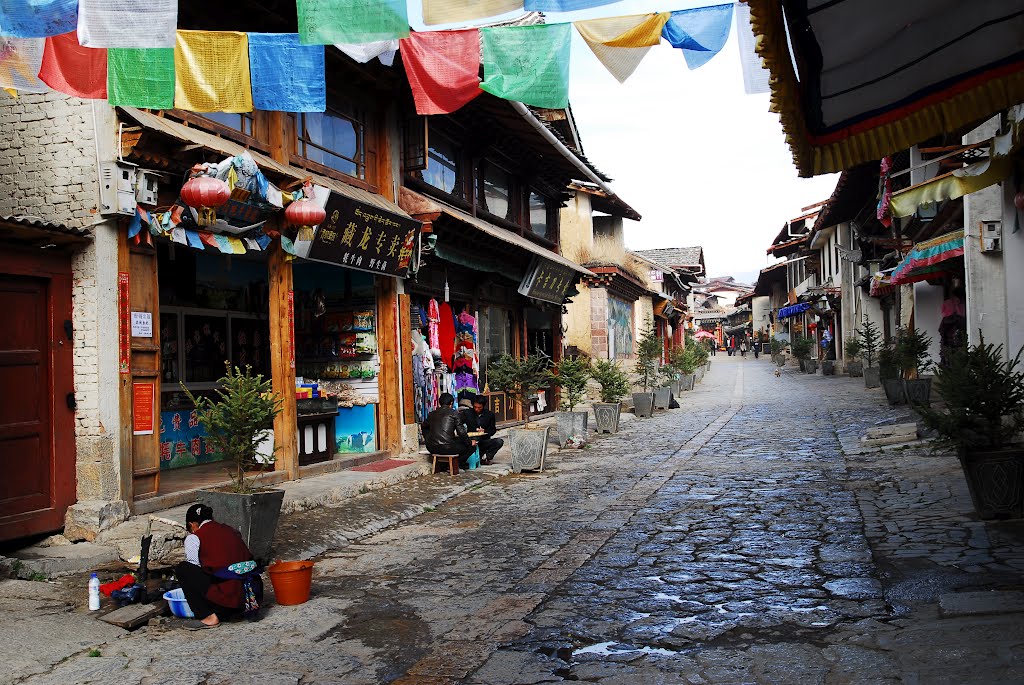
Dukezong, a Tibetan town in Shangrila, Yunnan Province, offers sanctuary to all those seeking refuge from the cares of city life. Dukezong's authentic Tibetan dwellings, gilded prayer halls and pagodas, and lanterns of various shapes lighting the way along narrow, winding lanes are permeated with the grace and mystique of antiquity that enchants visitors the moment they set foot in it.
Fossil of Tibetan Culture

Dukezong, capital of Deqen Tibetan Autonomous Prefecture in northwestern Yunnan Province, is situated at an altitude of 3,200 meters above sea level, and is 700 kilometers from Kunming. The town has a history of 1300 years, during which time it has experienced both the flames of war and prosperity of frontier trade. Tibetans regard the shade of white as a sign of respect for their forefathers, the ancient Qiang people, who worshipped white stones. Shortly after the town was established, craftsmen found white clay in the region that could be ground down and used as paint. All dwellings were accordingly painted white. This is how Dukezong, Tibetan for ¡°city of white stone¡±, got its name. On a clear night, the ancient town reflects a silver sheen. This has engendered to another epithet: City of Moonlight. Its counterpart is Niwangzong Town by the Naizi River, known as the City of Sunshine. The Sun and Moon cities gave rise to the song "Sun and Moon in the Heart", which Tibetans have sung for more than 1,000 years.
Dukezong was a key stop on the Ancient Tea-Horse Trail and a focal point for Han-Tibetan exchanges. Despite its age, Dukezong is the largest and best-preserved Tibetan city among China's 147 Tibetan counties. It is also site of the largest ancient Tibetan community.
There was human life in Shangrila in the Paleolithic Age, and a tribal society inhabited it during the Western Zhou Dynasty (1100-771B.C.). It was in the 7th century that the Tubo Regime conquered Deqen, and built Dukezong. As one of the oldest towns in the region, it is also known as the "footstep of Shangrila." According to Tibetan Buddhist scriptures, there is a lost city called Shambhala in the Snow Mountains, shaped like an eight-petal lotus flower. The 1.6-square-kilometer Dukezong Town is also laid out in this design. All 1,084 of its houses radiate out from Turtle Hill at the town center, arranged in conformity with Tibetan Buddhist geomantic theory.
A City of Charm
People of Dukezong are warm, honest and always delighted to show tourists around their homes on request. Apur, 74 years old, lives in a two-story wooden structure on 66, Beimen Street at the city gate. He keeps firewood and livestock on the first floor and on the second one the wide porch whose beams are carved with five dragons, bedrooms, a guestroom, and a prayer hall. Apur always takes guests into the prayer hall to show them the shrine and its antique plaque carved with twin golden dragons. On the back is the inscription: Jiao from Shaanxi, 7th year of the reign of Ming Emperor Chongzhen (1634). The plaque is believed to have been carved by an artisan named Jiao who helped to build the house 370 years ago. Apur serves his guests with buttered tea while he tells them stories about his old house.
The old Tibetan way of life, as well as dwellings, are well preserved in Dukezong, as each barley wine-redolent lane testifies. Tibetan chess is played in local households as it has been for the past 1,000 years, and horse bells still tinkle along the ancient caravan path. Bonfires that are lit in the town square every night illuminate local musicians as they sing to and play traditional stringed instruments.
Visitors find Dukezong to be a treasure trove of old style jewelry, painted scrolls, cottage industry-produced earthenware, incense and religious ornaments. As its fame has reached far beyond China's borders, this ancient town is also surprisingly cosmopolitan.
People of different cultures staying in the Yunnan Tibet Posthouse communicate with ease, despite having no common language. The Hazelnut Bar is popular as a comfortable venue in which to observe and learn about Tibetan song and dance, and the Delhamo Bookstore is a good place to take a break during an afternoon stroll. In the depths of one lane American Amy is working hard on renovations to an old hut she has rented. William from Britain is busy organizing an exhibition of his photographic works. Carter S. Malik, wife of Khalid Malik, UN resident coordinator in China, also once enjoyed a sojourn in a leased house in Dukezong.
Dukezong, this land of love, peace and sunshine, has always drawn throngs of migrants and travelers. Artists find it a source of inspiration, and those jaded from city life come here to get away from its purely material pursuits. Dukezong boasts the dual accomplishments of a perfectly preserved aboriginal culture in a town open to modernity and progress.
Admission Fee:¥0

You will only receive emails that you permitted upon submission and your email address will never be shared with any third parties without your express permission.
